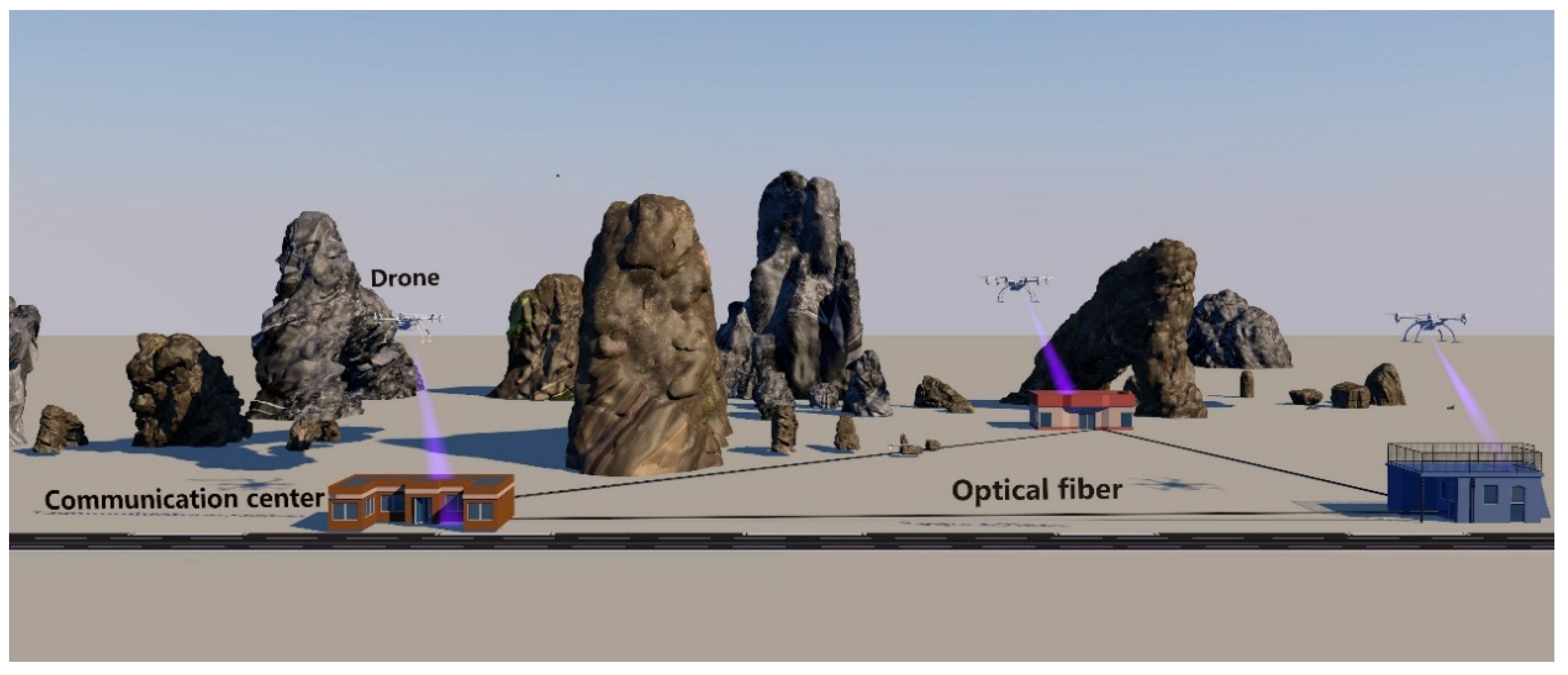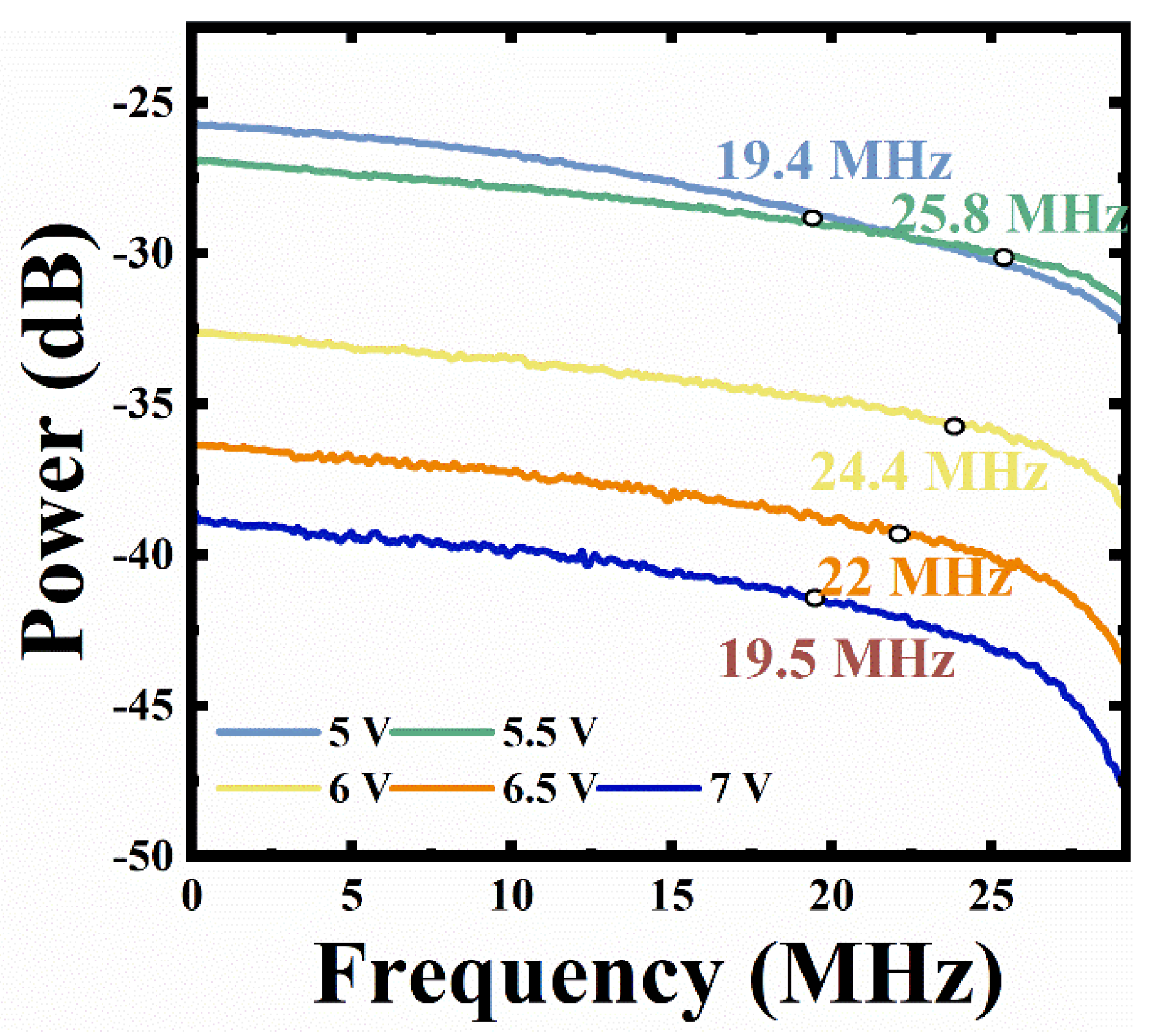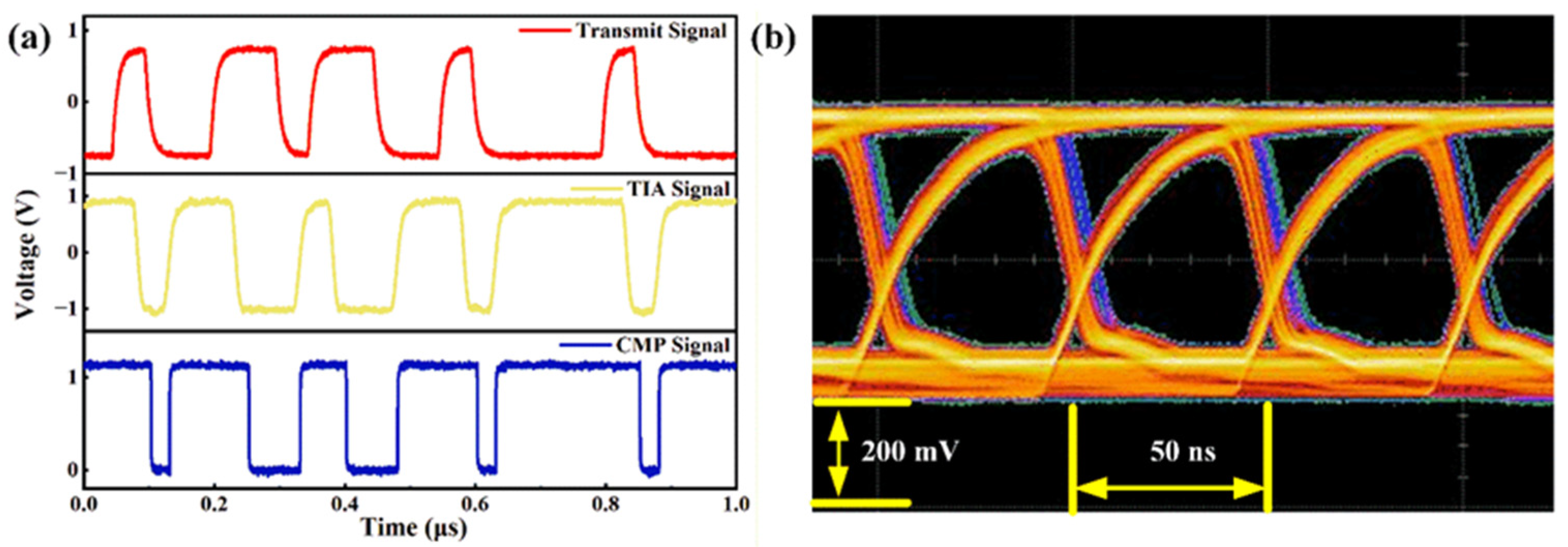Solar-Blind Mobile Deep Ultraviolet Optical Communication Utilizing Photomultiplier Tubes
Abstract
1. Introduction
2. System Overview
3. Experiments and Discussions
4. Conclusions
Author Contributions
Funding
Data Availability Statement
Conflicts of Interest
References
- Chow, C.-W. Recent Advances and Future Perspectives in Optical Wireless Communication, Free Space Optical Communication and Sensing for 6G. J. Light. Technol. 2024, 42, 3972–3980. [Google Scholar] [CrossRef]
- Ozgun, O.; Unverdi, N.O. Maritime Applications and Modeling of Optical Communication Technology. In Proceedings of the 2024 32nd Signal Processing and Communications Applications Conference (SIU), Mersin, Turkey, 15–18 May 2024; IEEE: New York, NY, USA, 2024. [Google Scholar]
- Hyun, Y.-J.; Park, H.; Han, S.-K. Pulse-Sharpened OOK Optical Transmission Using MZDI With Saturated EDFA in Space Laser Communication. J. Light. Technol. 2024, 42, 3237–3245. [Google Scholar] [CrossRef]
- Kannan, A.; Bhavana, V.; Younus, S.M.; Rehaman, S.M.; Krishnan, P. Experimental Demonstration and Performance Analysis of Free Space and Underwater Optical Wireless Communication Systems. Wirel. Pers. Commun. 2024, 134, 69–93. [Google Scholar] [CrossRef]
- Mikos-Nuszkiewicz, A.; Lukanowski, K.; Jarzyna, M.; Banaszek, K. Coherent Beam Combination for Deep Space Optical Communications; Hemmati, H., Robinson, B., Eds.; SPIE: Bellingham, WA, USA, 2025; Volume 13355. [Google Scholar]
- Chow, C.-W. Free Space Optical Communication Using Photonic Integration. In Proceedings of the 2024 IEEE Photonics Conference (IPC), Rome, Italy, 10–14 November 2024; IEEE: New York, NY, USA, 2024. [Google Scholar]
- Singh, M.; Chatterjee, D.; Suchita; Sunder, S.; Singh, K.; Krishna, M.; Mir, S.A.; Venkitesh, D. Advancements in Optical Communication Research: A Review of India’s Progress. IEEE Photonics J. 2024, 16, 0600309. [Google Scholar] [CrossRef]
- Storm, M.; Petrillo, K. Small Satellite Lunar Optical Communications for NASA Science and Artemis; Hemmati, H., Robinson, B., Eds.; SPIE: Bellingham, WA, USA, 2025; Volume 13355. [Google Scholar]
- Alves, P.U.; Hill, J.; Xie, E.; Durmusoglu, E.G.; Sharma, M.; Demir, H.V.; McKendry, J.J.D.; Dawson, M.D.; Laurand, N. Deep UV LED-Pumped Quantum Well Supraparticles for Visible Light Communication. In Proceedings of the 2024 IEEE Photonics Conference (IPC), Rome, Italy, 10–14 November 2024; IEEE: New York, NY, USA, 2024. [Google Scholar]
- Arya, S.; Chung, Y.H. A Comprehensive Survey on Optical Scattering Communications: Current Research, New Trends, and Future Vision. IEEE Commun. Surv. Tutor. 2024, 26, 1446–1477. [Google Scholar] [CrossRef]
- Chen, X.; Han, D.; Zhang, M.; Ren, T.; Wan, T. Experimental Research on Image Transmission over One Hundred Metres with Limited Bandwidth in a Semantic Ultraviolet Communication System. In Proceedings of the 2024 14th International Symposium on Communication Systems, Networks and Digital Signal Processing (CSNDSP), Rome, Italy, 17–19 July 2024; IEEE: New York, NY, USA, 2024; pp. 41–46. [Google Scholar]
- Maclure, D.M.; Chen, C.; McKendry, J.J.D.; Xie, E.; Hill, J.; Herrnsdorf, J.; Gu, E.; Haas, H.; Dawson, M.D. Hundred-Meter Gb/s Deep Ultraviolet Wireless Communications Using AlGaN Micro-LEDs. Opt. Express 2022, 30, 46811–46821. [Google Scholar] [CrossRef]
- Mo, X.; Liang, Y.; Wang, L.; Qi, Z.; Zhou, J.; Zhang, L.; Liu, P.; Gou, J.; Wang, Y. Solar-Blind Deep Ultraviolet Light Communication Network. Opt. Express 2025, 33, 36280–36292. [Google Scholar] [CrossRef]
- Ozel, T.; Sari, E.; Nizamoglu, S.; Demir, H.V. Violet to Deep-Ultraviolet InGaN/GaN and GaN/AIGaN Quantum Structures for UV Electroabsorption Modulators. J. Appl. Phys. 2007, 102, 113101. [Google Scholar] [CrossRef]
- Toyoshima, M. Recent Trends in Space Laser Communications for Small Satellites and Constellations. J. Light. Technol. 2021, 39, 693–699. [Google Scholar] [CrossRef]
- Xiao, H.; Zhang, K.; Ruan, J.; Hao, J.; Sun, C. Optical and Communication Performance Investigation of UV and DUV Light-Stimulated Quantum Dots. IEEE Trans. Electron Devices 2024, 71, 4187–4195. [Google Scholar] [CrossRef]
- Xiao, H.; Zhang, K.; Xu, B.; Shen, H.; Wang, L.; Sun, C. High-Brightness Green CdSe/ZnS Quantum Dots Stimulated by Solar-Blind Deep-Ultraviolet Light in Optical Wireless Communications. Opt. Lett. 2024, 49, 3596–3599. [Google Scholar] [CrossRef]
- Xu, Z.; Sadler, B.M. Ultraviolet Communications: Potential and State-of-the-Art. IEEE Commun. Mag. 2008, 46, 67–73. [Google Scholar] [CrossRef]
- Yan, L.; Shi, L. Deep Fusion Technology of Optical Communication Channel Based on Multicarrier Modulation. Opt. Rev. 2019, 26, 537–548. [Google Scholar] [CrossRef]
- Zhao, T.; Lv, X.; Zhang, H.; Zhang, S. Wireless Ultraviolet Scattering Channel Estimation Method Based on Deep Learning. Opt. Express 2021, 29, 39633–39647. [Google Scholar] [CrossRef] [PubMed]
- Marso, M.; Mikulics, M.; Lüth, H.; Sofer, Z.; Kordoš, P.; Hardtdegen, H. Hybrid optoelectronics based on a nanocrystal/III-N nano-LED platform. Adv. Semicond. Devices Microsyst. 2016, 77–80. [Google Scholar] [CrossRef]
- Zhang, R.; Shao, Y.; Li, M.; Lu, L.; Eldar, Y.C. Optical Integrated Sensing and Communication with Light-Emitting Diode. In Proceedings of the 2024 IEEE International Conference on Communications Workshops (ICC Workshops), Denver, CO, USA, 9–13 June 2024; pp. 2059–2064. [Google Scholar]
- He, R.; Wang, Y.; Song, Y.; Ma, T.; Li, Z.; Zha, L.; Sun, L.; Liu, Z.; Pan, Z.; Ran, J.; et al. III—Nitride Micro—Array Integration for Photon Transceiver. Laser Photonics Rev. 2025, e00815. [Google Scholar] [CrossRef]
- Mikulics, M.; Kordoš, P.; Gregušová, D.; Sofer, Z.; Winden, A.; Trellenkamp, S.; Moers, J.; Mayerand, J.; Hardtdegen, H. Conditioning nano-LEDs in arrays by laser-micro-annealing: The key to their performance improvement. Appl. Phys. Lett. 2021, 118, 043101. [Google Scholar] [CrossRef]
- Liu, J.; Zhao, T.; Gao, Z.; Li, H. Modeling and application of array light sources in ultraviolet communication systems. Opt. Commun. 2025, 574, 131190. [Google Scholar] [CrossRef]
- Li, D.; Hu, J.; Hou, Y.; Wang, S.; Chi, N.; Zhang, S.; Wu, F.; Shen, C. High-Speed Optical Wireless Communication Based on UV LEDs. In Proceedings of the 2022 IEEE 14th International Conference on Advanced Infocomm Technology (ICAIT), Chongqing, China, 8–11 July 2022; pp. 60–63. [Google Scholar]
- Razeghi, M. Deep Ultraviolet Light-Emitting Diodes and Photodetectors for UV Communications; Eldada, L., Lee, E., Eds.; SPIE: Bellingham, WA, USA, 2005; Volume 5729, pp. 30–40. [Google Scholar]
- Kang, Y.; Zhao, J.; Wu, J.; Zhang, L.; Zhao, J.; Zhang, Y.; Zhao, Y.; Wang, X. Superior Deep-Ultraviolet Source Pumped by an Electron Beam for NLOS Communication. IEEE Trans. Electron Devices 2020, 67, 3391–3394. [Google Scholar] [CrossRef]
- Yu, H.; Memon, M.; Jia, H.; Ding, Y.; Xiao, S.; Liu, X.; Kang, Y.; Wang, D.; Zhang, H.; Fang, S.; et al. Deep-Ultraviolet LEDs Incorporated with SiO2-Based Microcavities Toward High-Speed Ultraviolet Light Communication. Adv. Opt. Mater. 2022, 10, 2201738. [Google Scholar] [CrossRef]
- Yu, H.; Memon, M.H.; Xiao, S.; Sun, H. IEEE Efficient DUV Micro-LED and Arrays for Various Applications. In Proceedings of the 2023 IEEE Photonics Conference (IPC), Orlando, FL, USA, 12–16 November 2023. [Google Scholar]
- Wang, R.; Yu, H.; Memon, M.H.; Gao, Z.; Luo, Y.; Kang, Y.; Du, Y.; Tang, Z.; Sun, H. Integrated Deep-Ultraviolet Micro-LED Array with Ultralow Contact Resistance and Ultrahigh Bandwidth for Intermixed Solar-Blind Optical Wireless Communication. IEEE Electron Device Lett. 2024, 45, 2479–2482. [Google Scholar] [CrossRef]
- Qi, Z.; Wang, L.; Liang, Y.; Liu, P.; Zhu, H.; Wang, Y. Deep-Ultraviolet Light Communication in Sunlight Using 275-Nm LEDs. Appl. Phys. Lett. 2023, 123, 161109. [Google Scholar] [CrossRef]







Disclaimer/Publisher’s Note: The statements, opinions and data contained in all publications are solely those of the individual author(s) and contributor(s) and not of MDPI and/or the editor(s). MDPI and/or the editor(s) disclaim responsibility for any injury to people or property resulting from any ideas, methods, instructions or products referred to in the content. |
© 2025 by the authors. Licensee MDPI, Basel, Switzerland. This article is an open access article distributed under the terms and conditions of the Creative Commons Attribution (CC BY) license (https://creativecommons.org/licenses/by/4.0/).
Share and Cite
Zhang, L.; Li, T.; Wang, Y. Solar-Blind Mobile Deep Ultraviolet Optical Communication Utilizing Photomultiplier Tubes. Photonics 2025, 12, 1125. https://doi.org/10.3390/photonics12111125
Zhang L, Li T, Wang Y. Solar-Blind Mobile Deep Ultraviolet Optical Communication Utilizing Photomultiplier Tubes. Photonics. 2025; 12(11):1125. https://doi.org/10.3390/photonics12111125
Chicago/Turabian StyleZhang, Lei, Tianle Li, and Yongjin Wang. 2025. "Solar-Blind Mobile Deep Ultraviolet Optical Communication Utilizing Photomultiplier Tubes" Photonics 12, no. 11: 1125. https://doi.org/10.3390/photonics12111125
APA StyleZhang, L., Li, T., & Wang, Y. (2025). Solar-Blind Mobile Deep Ultraviolet Optical Communication Utilizing Photomultiplier Tubes. Photonics, 12(11), 1125. https://doi.org/10.3390/photonics12111125



